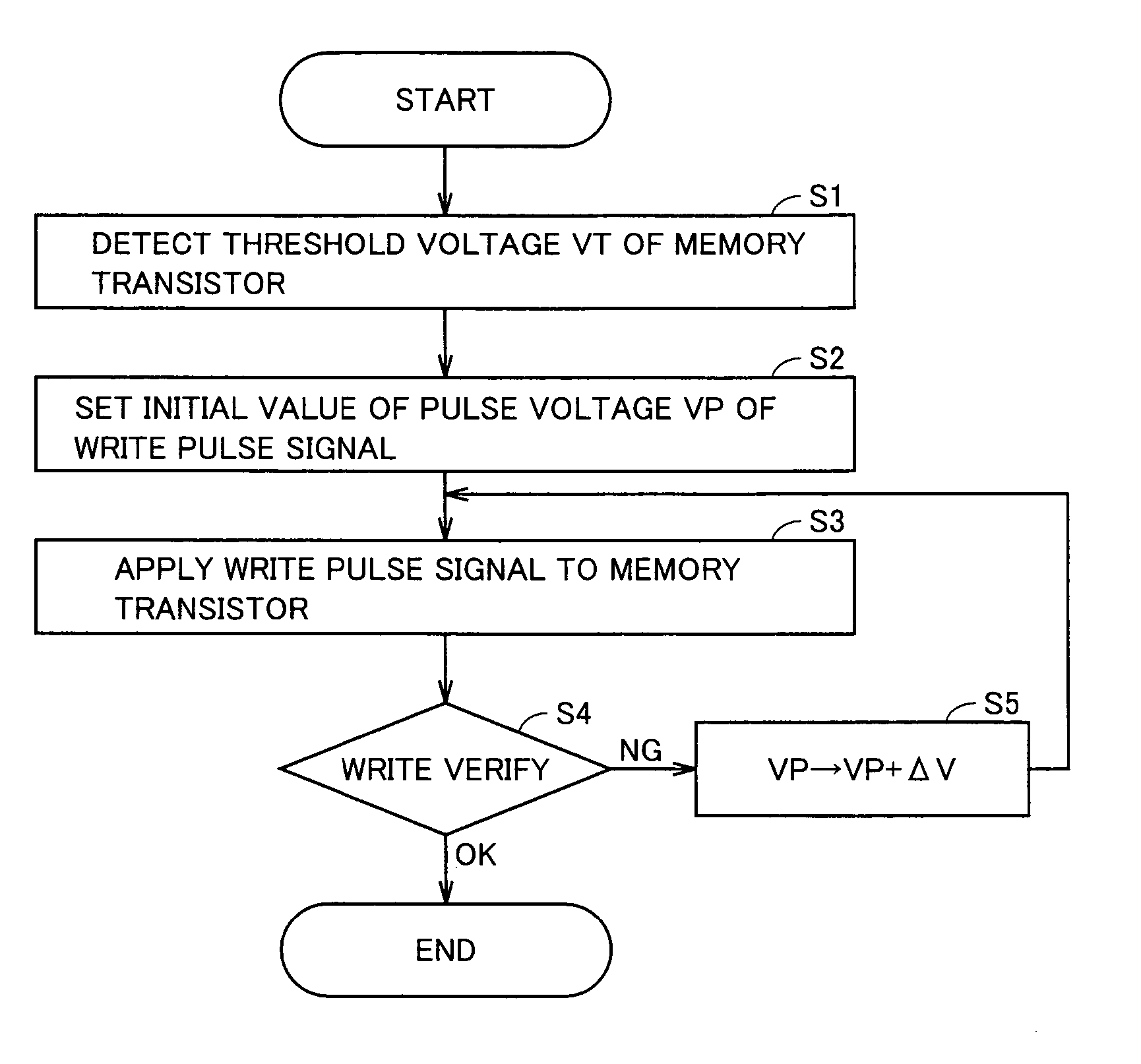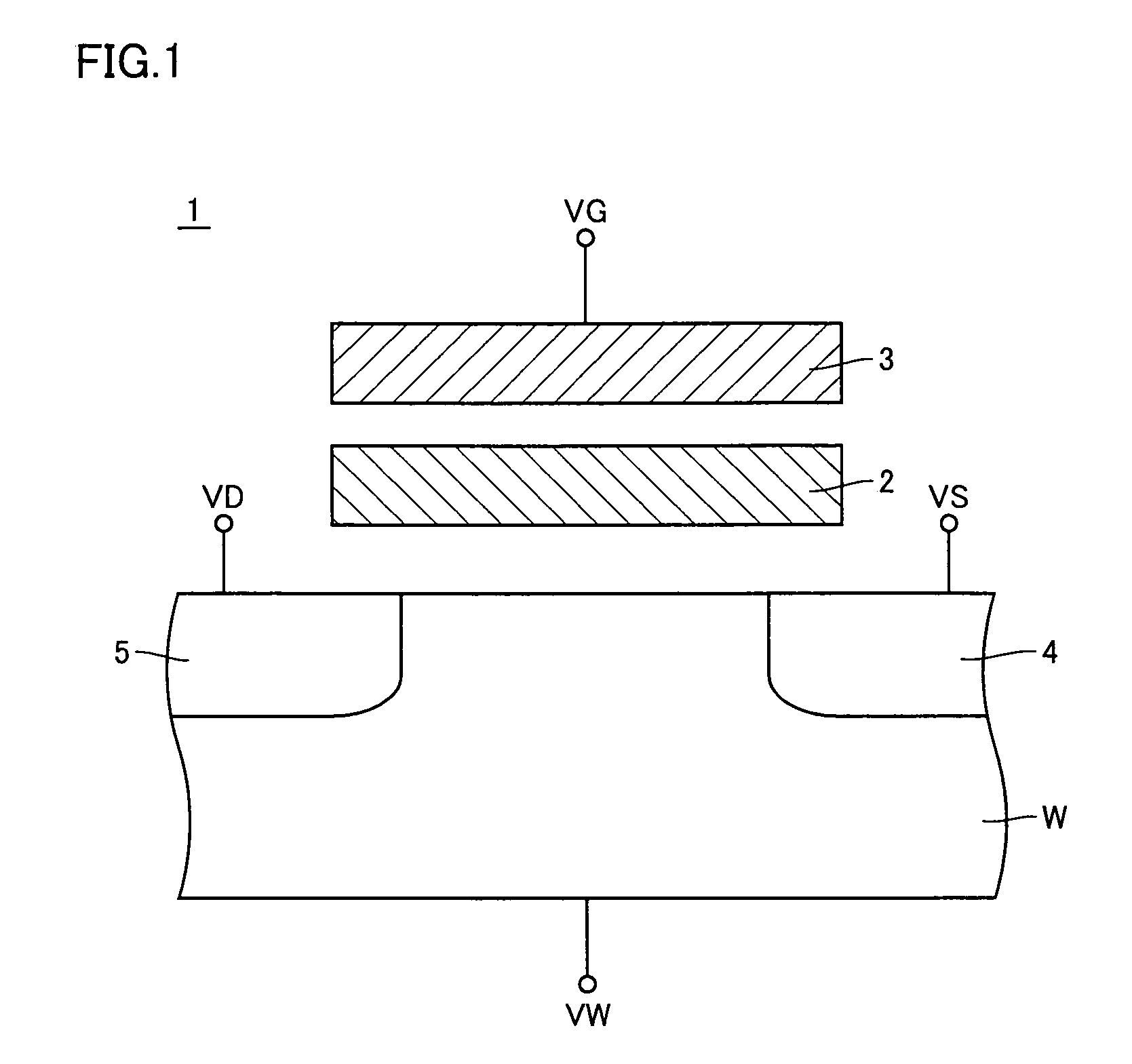Non-volatile semiconductor memory device with memory transistor
a semiconductor memory and transistor technology, applied in static storage, digital storage, instruments, etc., can solve the problems of excessive disadvantageous increase of threshold voltage, so as to reduce the current consumption and limit the threshold voltage of memory transistors.
- Summary
- Abstract
- Description
- Claims
- Application Information
AI Technical Summary
Benefits of technology
Problems solved by technology
Method used
Image
Examples
first embodiment
[0036
[0037]FIG. 1 is a cross section of a configuration of a memory transistor 1 of a flash memory in accordance with a first embodiment of the present invention. In FIG. 1, this memory transistor 1 includes a floating gate 2 formed above a surface of a well W at a semiconductor substrate with an insulating layer interposed, a control gate 3 formed thereabove with an insulating layer interposed, and a source 4 and a drain 5 formed on the well W surface on the opposite sides of gates 2, 3, respectively. Prescribed voltages VW, VG, VS, VD are applied to well W, control gate 3, source 4, and drain 5, respectively. Threshold voltage VT of memory transistor 1 varies depending on the number of electrons in floating gate 2.
[0038]In a reading operation, as shown in FIG. 2A, 1V is applied to drain 5 of memory transistor 1, 3.3V is applied to control gate 3, and 0V is applied to source 4 and well W, so that it is determined whether a current ID between drain 5 and source 4 exceeds a prescribe...
second embodiment
[0062
[0063]FIG. 14 is a flow chart illustrating a method employed in the present flash memory to write data in a second embodiment. With reference to FIG. 14 at step S11 threshold voltage VT of a selected memory transistor 1 is detected and at step S12 the threshold voltage VT value detected is used to set an initial value of pulse voltage VP of a write pulse signal. This process is identical to that described in the first embodiment.
[0064]Then at step S13 memory transistor 1 receives the write pulse signal and sense amplifier 15 detects the memory transistor 1 drain current ID and at step S14 verify control circuit 21 is driven by the drain current ID value detected to set step voltage ΔV. As shown in FIG. 15, the memory transistor 1 drain current ID is smaller for threshold voltage VT changing faster and is larger for threshold voltage VT changing slower. Accordingly, as shown in FIG. 16, when drain current ID is small, threshold voltage VT readily varies, and step voltage ΔV is a...
third embodiment
[0068
[0069]FIG. 18 is a circuit block diagram showing a main portion of the present flash memory in a third embodiment. FIG. 18 shows a portion associated with two data signals D1 and D2. In reality, a large number of columns are provided for a single data signal and a large number of memory transistors 1 are provided for a single column. To simplify the drawing and description, however, FIG. 18 shows a single column is shown for a single data signal and two memory transistors 1 are shown for a single column.
[0070]Two rows of memory transistors 1 are associated with word lines WL1 and WL2, respectively, and two columns of memory transistors 1 are associated with bit lines BL1 and BL2, respectively, and the four memory transistors 1 share source line SL. Memory transistor 1 has a control gate connected to the corresponding word line WL, a drain to the corresponding bit line BL, a source to the corresponding source line SL, and a back gate (well W) receiving a well voltage VW.
[0071]Wo...
PUM
 Login to View More
Login to View More Abstract
Description
Claims
Application Information
 Login to View More
Login to View More - R&D
- Intellectual Property
- Life Sciences
- Materials
- Tech Scout
- Unparalleled Data Quality
- Higher Quality Content
- 60% Fewer Hallucinations
Browse by: Latest US Patents, China's latest patents, Technical Efficacy Thesaurus, Application Domain, Technology Topic, Popular Technical Reports.
© 2025 PatSnap. All rights reserved.Legal|Privacy policy|Modern Slavery Act Transparency Statement|Sitemap|About US| Contact US: help@patsnap.com



